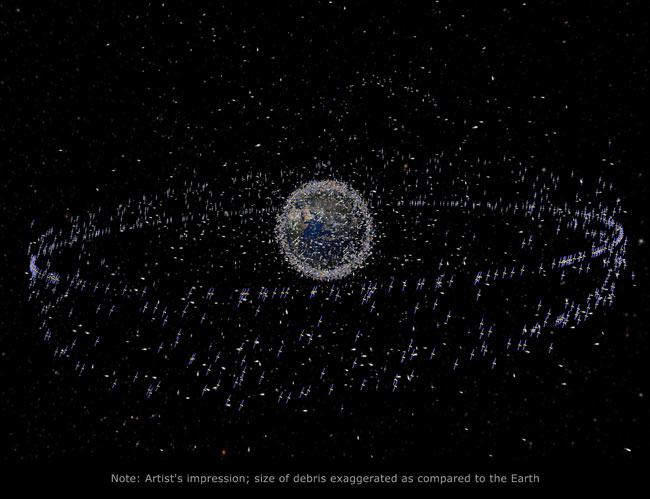
Fast-moving chunks of space debris zipped uncomfortably close to the International Space Station twice in the past week — cosmic close calls that will likely become more common over the next several years, experts predict.
For one thing, after 50 years of spaceflight there is just more junk up there than there used to be, sharing space with vehicles and their human crews. And this debris can snowball — as when satellites collide, spawning thousands of new pieces of orbiting junk.
The sun is also entering an active period, which puffs up Earth's atmosphere and increases orbital drag — causing higher-altitude space debris to rain down on spacecraft below. Solar activity shouldn't hit its peak until 2012 or 2013, so orbiting astronauts may experience some more close shaves soon.
"I think that over the next two or three years, this is going to happen more often," NASA's Gene Stansbery told SPACE.com. Stansbery is the program manager of NASA's Orbital Debris Office at Johnson Space Center in Houston.
Recent space junk scares
The recent debris flybys at the space station are just the latest encounters between crewed spacecraft and space junk.
Tuesday (April 5), a piece of debris spawned by a 2007 Chinese anti-satellite test threatened the station and its three-person crew. It takes about three days' notice to move the station out of the way in a so-called "debris avoidance maneuver," NASA officials said. This piece wasn't detected in time.
Breaking space news, the latest updates on rocket launches, skywatching events and more!
So astronauts prepared to take shelter in their attached Soyuz spacecraft, which can serve as a sort of lifeboat. Spaceflyers have resorted to this strategy four or five times in the station's history, Stansbery said.
In the end, tracking data indicated that the debris would miss the station, so the astronauts did not have to hunker down in the Soyuz.
That debris encounter came four days after another close shave.
On Friday (April 1), flight controllers moved the space station clear of a piece of space junk left over from a 2009 collision between two satellites. The orbiting lab has made a dozen such debris avoidance maneuvers since 1999, five of them in the last 2 1/2 years, Stansbery said.
A growing problem
Pieces of space trash — which may be defunct spacecraft, abandoned launch vehicles, or fragments from satellite collisions — zip around Earth at speeds up to 17,500 mph (28,163 kph).
That's so fast that even orbiting paint flecks can damage a spacecraft. And there's a lot of this stuff — much of it larger and far more dangerous than paint flecks.
There are more than 20,000 pieces bigger than a softball, for example, and more than 500,000 bigger than a marble, according to NASA officials. Researchers are tracking more than 22,000 chunks of space debris in Earth orbit, but they can't watch it all.
The 2007 Chinese anti-satellite test added about 3,000 pieces of space junk to the orbiting population, NASA officials said. The 2009 collision — between a defunct Russian satellite and a U.S. Iridium communications satellite — contributed another 2,000 or so.
Sun is waking up
These 5,000 new fragments initially started out higher up in Earth orbit than the space station, which flies around the Earth about 220 miles (354 km) up. But they're starting to come closer to the station now, because solar activity is ramping up.
The sun is emerging from an extended quiescent period, and increased solar activity is causing Earth's atmosphere to expand, Stansbery said. As a result, the drag on high-altitude space junk is increasing, causing the stuff to spiral lower and lower.
"When the solar cycle is ramped up, that's typically when we get a lot of this rain-down from higher altitudes," Stansbery said.
Since the peak of solar activity is not expected until 2012 or 2013, astronauts aboard the station could be in for some more close calls in the near future, he added. [Video: The Sun Woke Up on Valentine's Day]
Prevention the best medicine
NASA and the U.S. Department of Defense work together to keep tabs on space junk. They also coordinate as much as they can with other nations, since space debris is a global problem.
"There is a lot of cooperation internationally on this topic," Stansbery said.
If it's hard to keep track of millions of pieces of space trash, it's even tougher to get rid of them. Removing the threatening junk would be nice, but at the moment doing so on a large scale remains out of reach.
"Our feeling is, that's still a long way off," Stansbery said. "It's a very difficult technological problem."
So as a result, prevention may be the best cure for the space-debris problem right now.
"We're still concentrating on producing as little debris as possible," Stansbery said.
You can follow SPACE.com senior writer Mike Wall on Twitter: @michaeldwall. Follow SPACE.com for the latest in space science and exploration news on Twitter @Spacedotcom and on Facebook.
Join our Space Forums to keep talking space on the latest missions, night sky and more! And if you have a news tip, correction or comment, let us know at: community@space.com.

Michael Wall is a Senior Space Writer with Space.com and joined the team in 2010. He primarily covers exoplanets, spaceflight and military space, but has been known to dabble in the space art beat. His book about the search for alien life, "Out There," was published on Nov. 13, 2018. Before becoming a science writer, Michael worked as a herpetologist and wildlife biologist. He has a Ph.D. in evolutionary biology from the University of Sydney, Australia, a bachelor's degree from the University of Arizona, and a graduate certificate in science writing from the University of California, Santa Cruz. To find out what his latest project is, you can follow Michael on Twitter.
